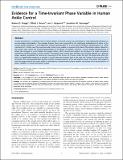Evidence for a Time-Invariant Phase Variable in Human Ankle Control
Author(s)
Gregg, Robert D.; Hargrove, Levi J.; Sensinger, Jonathon W.; Rouse, Elliott J.
DownloadGregg-2014-Evidence for a time-.pdf (1.766Mb)
PUBLISHER_CC
Publisher with Creative Commons License
Creative Commons Attribution
Terms of use
Metadata
Show full item recordAbstract
Human locomotion is a rhythmic task in which patterns of muscle activity are modulated by state-dependent feedback to accommodate perturbations. Two popular theories have been proposed for the underlying embodiment of phase in the human pattern generator: a time-dependent internal representation or a time-invariant feedback representation (i.e., reflex mechanisms). In either case the neuromuscular system must update or represent the phase of locomotor patterns based on the system state, which can include measurements of hundreds of variables. However, a much simpler representation of phase has emerged in recent designs for legged robots, which control joint patterns as functions of a single monotonic mechanical variable, termed a phase variable. We propose that human joint patterns may similarly depend on a physical phase variable, specifically the heel-to-toe movement of the Center of Pressure under the foot. We found that when the ankle is unexpectedly rotated to a position it would have encountered later in the step, the Center of Pressure also shifts forward to the corresponding later position, and the remaining portion of the gait pattern ensues. This phase shift suggests that the progression of the stance ankle is controlled by a biomechanical phase variable, motivating future investigations of phase variables in human locomotor control.
Date issued
2014-02Department
Program in Media Arts and Sciences (Massachusetts Institute of Technology)Journal
PLoS ONE
Publisher
Public Library of Science
Citation
Gregg, Robert D., Elliott J. Rouse, Levi J. Hargrove, and Jonathon W. Sensinger. “Evidence for a Time-Invariant Phase Variable in Human Ankle Control.” Edited by Manabu Sakakibara. PLoS ONE 9, no. 2 (February 18, 2014): e89163.
Version: Final published version
ISSN
1932-6203